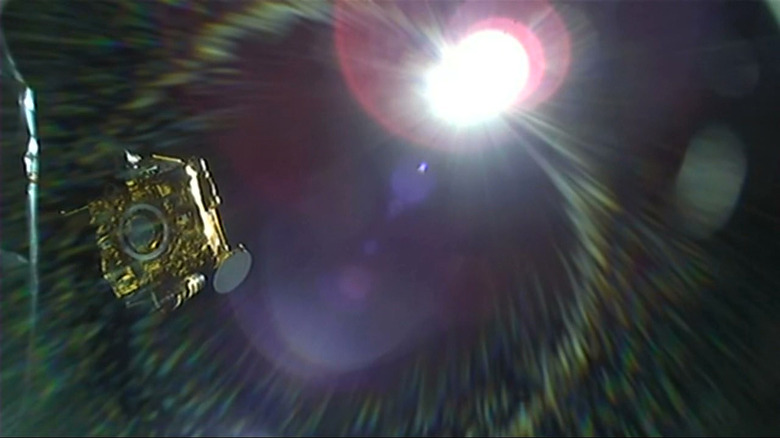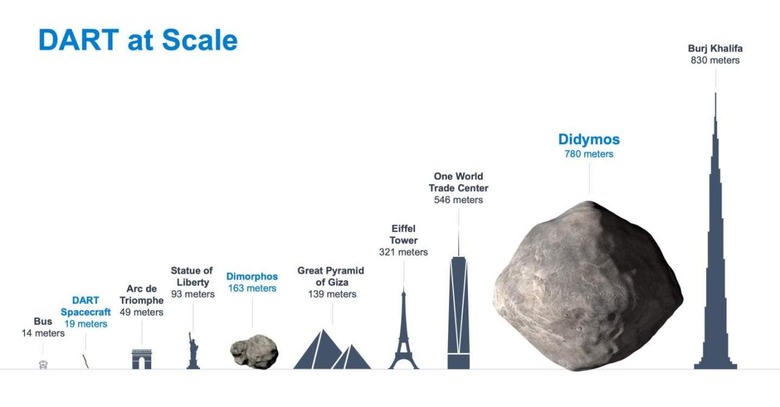NASA's DART Mission Launches And Heads Towards Its Demise
Scientists have confirmed that asteroids have impacted Earth in the past. Most of those impacts left craters of various sizes and caused no real harm to the planet, but there have been some catastrophic impacts in the distant past. One of the biggest impacts ever to take place on the planet is the Chicxulub Impactor, estimated to have been six miles wide. That massive impact left a crater 90 miles wide on the Mexico Yucatán Peninsula and killed most life on the planet.
A massive asteroid impact that disrupts or destroys life on Earth seems like the stuff of science fiction, and while unlikely, it could happen. NASA and other space agencies are constantly on the lookout for near-Earth asteroids that pose a risk and for unknown asteroids that appear unexpectedly in the vastness of space. While working to discover and track asteroids that are potentially harmful to our planet, NASA is also looking for ways to deflect an asteroid should the need arise. NASA confirmed this week that after years of work, the NASA DART, or Double Asteroid Redirection Test, has finally launched.
NASA chose SpaceX as its launch partner, and yesterday a Falcon 9 rocket successfully pushed DART into space. While NASA and SpaceX have dealt with significant delays for other missions recently, DART was able to lift off on Tuesday, November 23, as planned. Launch occurred at Space Launch Complex 4 E at Vandenberg Space Force Base in California. SpaceX did have a backup launch window on November 24, at 10:20 PM PST, but didn't need that backup date.
The Falcon 9 rocket used to put DART into orbit celebrated its third flight. The same booster was previously used for a Starlink mission and for the launch of Sentinel-6A. After the Falcon 9 separated, it was successfully returned to Earth, where it landed on the SpaceX drone ship Of Course I Still Love You in the Pacific Ocean.

The DART spacecraft was filled with fuel and made ready to launch earlier this month. At the same time, crewmembers were performing the final checks on the spacecraft and began to run dress rehearsals. Reaching the point where the spacecraft is being fueled and ready for launch was quite a milestone in a project that had been under construction for over a year, dealing with restrictions imposed by the pandemic.
The mission was constructed using some new technologies that will be tested, including the NEXT-C ion propulsion system specifically meant to help improve efficiency for deep space missions. Another new technology used on the spacecraft is a revised antenna design that has been flattened and slotted with the goal of more efficient communications between the spacecraft and Earth.
While many NASA missions are crammed full of various instruments, a single camera is aboard to support this mission. DART is equipped with a camera called DRACO to allow it to visualize and make an impact with its target in space. DART does have an Italian Space Agency satellite aboard called the LICIACube that is tagging along to capture images of the impact with its asteroid target and any changes to the asteroid's path. DART arrived at Vandenberg Space Force Station in late October.
DART is the first kinetic impactor mission in history with the goal of testing planetary defenses by hitting an asteroid with the spacecraft in an attempt to change its course. The target for the mission is an asteroid moonlet called Dimorphos that is orbiting a larger companion asteroid called Didymos. NASA has been clear since it began planning the mission that Dimorphos poses no risk to the planet. The mission is meant to gather data to help us learn what it would take to deflect an asteroid that does pose a risk to Earth at some point in the future.
NASA began to talk about the mission early in 2019. Didymos is a small asteroid measuring about 525 feet across. That makes it less than a third the size of asteroid Bennu that was explored by another space mission. NASA chose the smaller target asteroid because of its size and the fact that it's orbiting around a larger asteroid quite quickly. Its size and orbit will make it easier for scientists on Earth to determine if the mission altered the orbit of its asteroid target.

While the small Italian satellite is tagging along to gather data on the immediate results of the mission, the ESA does have a companion mission that will launch in 2026 called Hera. That mission aims to survey both asteroids and gather better data than can be gleaned from Earth. Data gathered by that mission will include details on Didymos, including surface properties, mass, and what sort of crater was left behind after DART's impact.
Learning about protecting the planet from asteroids that appear suddenly is extremely important. NASA says that no asteroid it knows of larger than 140 meters poses a significant threat of impact with Earth for the next 100 years. However, there is a caveat with NASA admitting only about 40 percent of the asteroids that could threaten Earth have been discovered as of October 2021. It's the asteroids we don't know about that pose the biggest threat to our planet.
Another reason that the binary near-Earth asteroid Didymos was chosen is because the smaller moonlet is exactly the type of asteroid that poses a threat to the planet. As we saw back in 2013 when a meteor streaked across the sky in Russia, smaller objects can cause significant amounts of damage. In that Russian event, the meteor exploded in the sky over a populated area and caused significant amounts of damage, including blowing glass out of buildings. There was some rather strange damage caused by the meteor, with some people reporting their windows didn't shatter, but glass objects inside their homes did. Some also reported the meteor explosion damaged their electronics. Estimates suggested between 500 and 1000 people were injured from the meteor's shockwave.
One of the biggest fears unknown asteroids pose is that we won't know they're there until they're so close to the Earth launching a mission to deflect them would be unlikely. It took NASA years to get DART ready, and there is no indication of how quickly a similar mission could be readied and launched if a serious threat to the planet was discovered.
